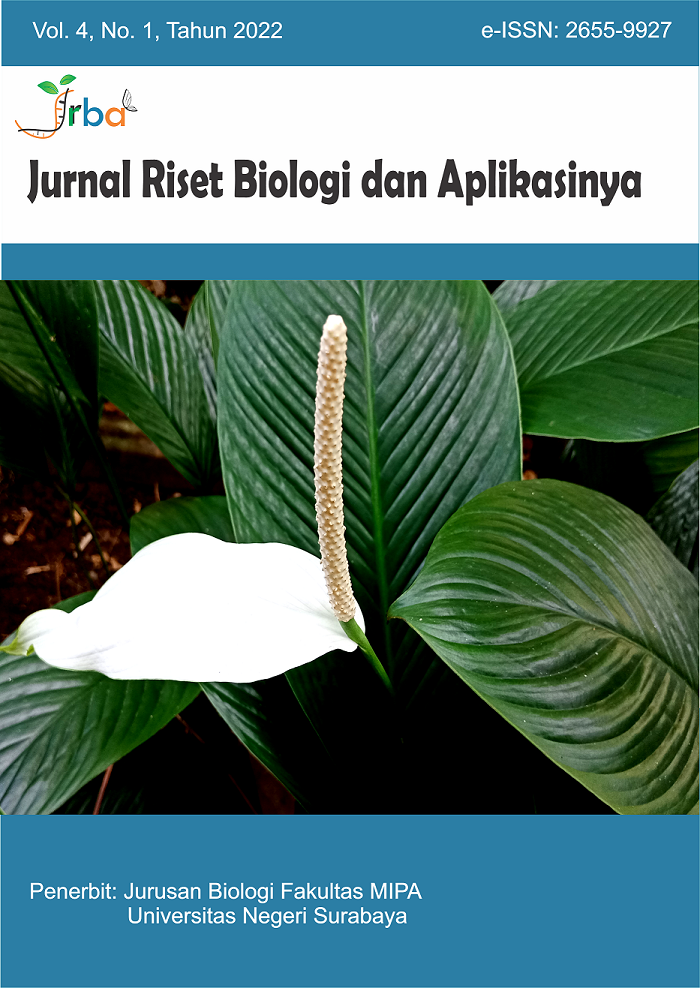Beta-Glucosidase 1 (bgl1) Gene Analysis in Mutant and Wild-type of Penicillium sp. ID10-T065
DOI:
https://doi.org/10.26740/jrba.v4n1.p1-8Keywords:
Base alteration, Beta-glucosidase, Mutation, Penicillium, Transition, Transversion.Abstract
In the previous study, Penicillium sp. ID10-T065 has been mutated using ultraviolet (UV), ethyl methyl sulfonate (EMS) and the combination of UV-EMS to increase Beta-glucosidase (bgl) activity. There were three mutants selected, UV13 (UV mutant), EM31 (EMS mutant), and UM23 (UV-EMS mutant). This study examined the mutations in the bgl gene encoding (bgl1) as well as sequence differences between mutants and wild-type of Penicillium sp. ID10-T065. The gene analysis was performed by PCR amplification and sequencing of the bgl1 gene. The results of bgl1 gene sequences (600 bp) from mutants were aligned with the wild-type, it was discovered that there were base alterations from position 2025 to 2050. Mutant UV13 showed the highest base alterations (7 bases) which occurred at position 2027 (T?C); 2036 (T?G); 2040 (T?G); 2047 (G?C); and 2048-2050 (TTG?GGA). Mutant EM31 showed alterations in five bases at positions 2034 (G?A), 2036 (T?G), 2037 (G?C), 2044 (G?C), and 2047 (G?T). Mutant UM23 showed two base alterations at position 2025 (T?A) and 2037 (G?C). UV irradiation and EMS mutation resulted in transition and transversion DNA, whereas the combination of UV-EMS mutation resulted in transversion mutations. Base alterations in UV13 and EM31 mutants, causing missense and silent mutation, while in UM23 mutant only silent mutations occur. The bgl1 gene analysis showed that mutation using UV light was more effective than using EMS or a combination of UV-EMS in Penicillium sp. ID10-T065.
References
Ega, S. L., Drendel, G., Petrovski, S., Egidi, E., Franks, A. E., & Muddada, S. (2020). Comparative analysis of structural variations due to genome shuffling of Bacillus Subtilis vs15 for improved cellulase production. International Journal of Molecular Sciences, 21(4). https://doi.org/10.3390/ijms21041299
Griffiths, A. J. F., Miller, J.H., Suzuki, D.T., Leontin, R.C., & Gelbart, W.M. (2000). An introduction to genetic analysis. 7th ed. New York: W.H. Freeman. From http//www.ncbi.nlm.nih.gov/books/NBK 21936
Hogg, S. (2005). Essential Microbiology. West Sussex: John Wiley & Sons, Ltd
Liu, G., Zhang, L., Wei, X., Zou, G., Qin, Y., Ma, L., Li, J., Zheng, H., Wang, S., Wang, C., Xun, L., Zhao, G. P., Zhou, Z., & Qu, Y. (2013). Genomic and Secretomic Analyses Reveal Unique Features of the Lignocellulolytic Enzyme System of Penicillium decumbens. PLoS ONE, 8(2). https://doi.org/10.1371/journal.pone.0055185
Luo, G. H., Li, X. H., Han, Z. J., Zhang, Z. C., Yang, Q., Guo, H. F., & Fang, J. C. (2016). Transition and transversion mutations are biased towards GC in transposons of Chilo suppressalis (Lepidoptera: Pyralidae). Genes, 7(10). https://doi.org/10.3390/genes7100072
Porceddu, A., & Camiolo, S. (2017). Patterns of spontaneous nucleotide substitutions in grape processed pseudogenes. Diversity, 9(4). https://doi.org/10.3390/d9040045
Syafriana, V., Nuswantara, S., Mangunwardoyo, W., & Lisdiyanti, P. (2014). Enhancement of ? -Glucosidase Activity in Penicillium sp. by Random Mutation with Ultraviolet and Ethyl Methyl Sulfonate. Annales Bogorienses, 18(2), 27-33. http://dx.doi.org/10.14203/ann.bogor.2014.v18.n2.27-33
Voet, D. & Voet, J.G. (2011). Biochemistry. 4th ed. New Jersey: John Wiley & Sons, Inc.
Downloads
Published
How to Cite
Issue
Section
License
Copyright (c) 2022 Jurnal Riset Biologi dan Aplikasinya

This work is licensed under a Creative Commons Attribution-NonCommercial 4.0 International License.
 Abstract views: 459
,
Abstract views: 459
, PDF Downloads: 577
PDF Downloads: 577












